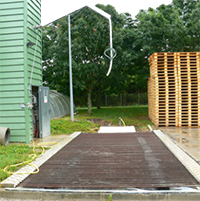DEMONSTRATING THE EFFECTIVENESS AND EASE OF USE OF THE BIOLOGICAL PROCESS

Copyright : Daniel Garcia/CEA
Wash station. The effluents are collected through the metal grating and transported toward the treatment basins.
A process for treating phytopharmaceutical effluents
The plan consists of a station for the washing and recovery of phytopharmaceutical effluents, which supplies a series of three lagooning basins. The basins are unventilated and cascading, and are seeded with a bacterial collection that degrades the active molecules of effluents.
A plan that has completed its proof of concept
A first analysis was conducted in a farm located in the southwest of France (Lot-et-Garonne) that grows wheat, soybean, sunflower, alfalfa and stone fruits. The initial results indicate an almost complete degradation (> 90%) of most of the active molecules discharged into the ponds.
To further characterize the process, the project intends to:
– diversify the nature of the molecules to be degraded by expanding the types of crops (viticulture, market gardening, arable crops, etc.)
– assess the functionality of the process according to the climatic conditions (such as a mountainous climate)
– compare two paired demonstrators, with and without seeding, so as to compare the efficiency of the process with a control that does not contain the added bacteria.

Copyright : Daniel Garcia/CEA
The lagooning system consist of three covered basins, wich are unventilated ans cascading. On the right, the basins take on the color of the bacteria with wich they were seeded.
Bacteria for use in decontamination
The process is based on the bio-decontamination ability that some microorganisms have to degrade active molecules. For the “Phytobarre” process, the laboratory of cellular bioenergetics (CEA/LBC) selected a collection of photosynthetic* bacteria that are able to adapt to the established lagooning system (i.e. polluted and unventilated waters). The laboratory will be responsible for producing this non-transformed and non-pathogenic collection of environmental bacterial strains. The laboratory will also establish the type of conservation and the most suitable packaging for a simple and easy manipulation by non-specialist users.
Study of the degradation of phytopharmaceutical products
Throughout the project, the content of phytopharmaceutical products in the basins will be regularly analyzed by an approved laboratory. A more specific monitoring will be performed at the paired demonstrator located at the partner “La Pugère”. This will allow comparing the degradation of products in the presence and absence of the bacterial collection.
*Photosynthetic organisms: organisms that use light as an energy source to produce their own organic matter. Plants and certain bacteria are able to carry out the photosynthesis reaction.




